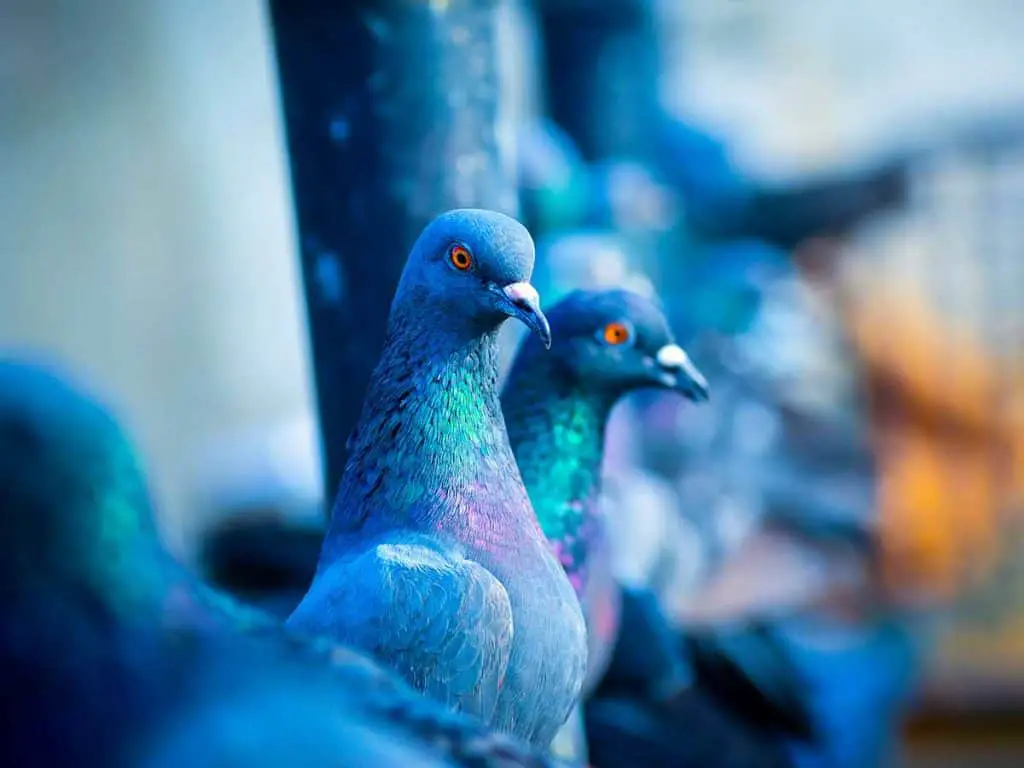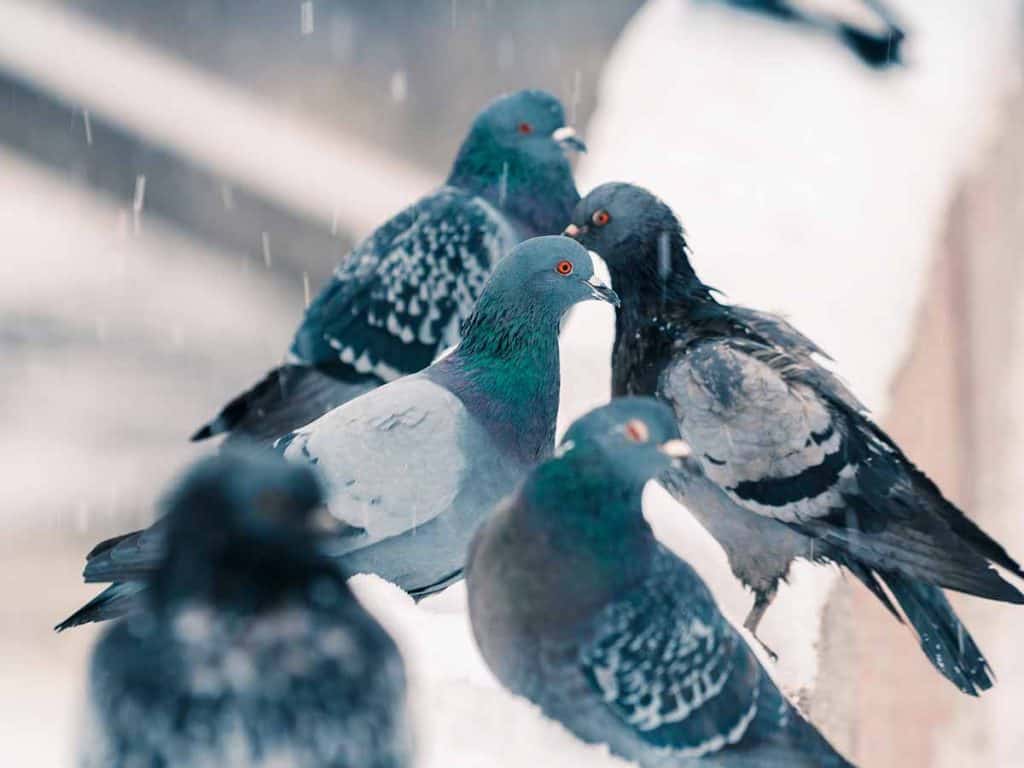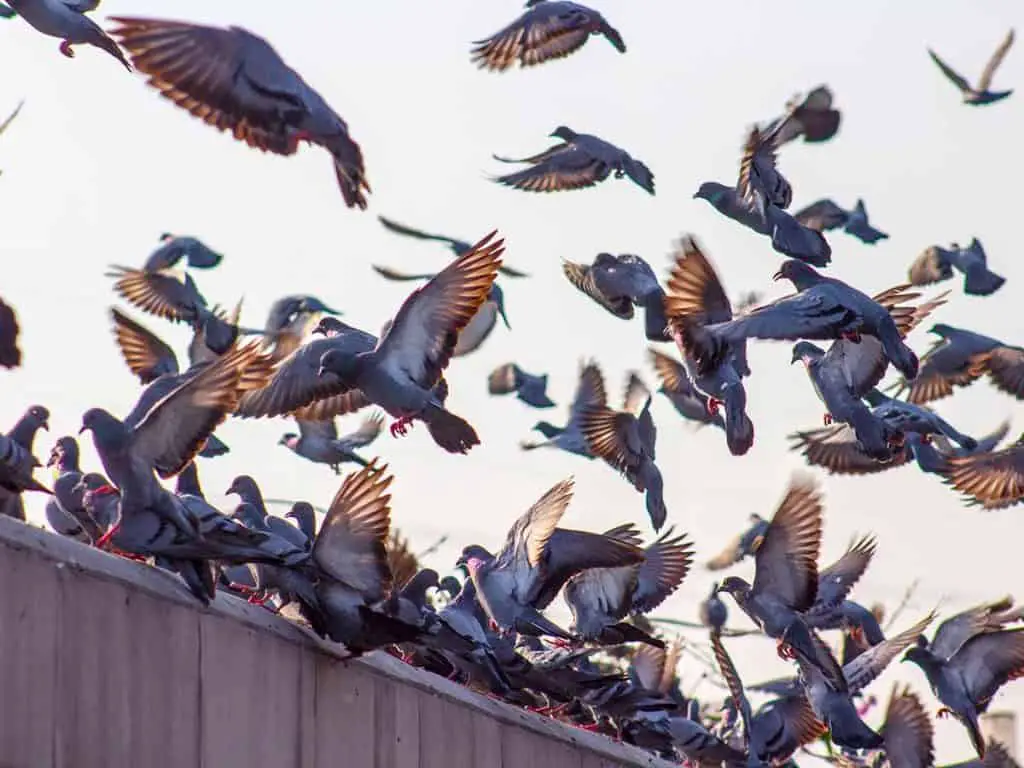Get Rid of Pigeons (10 Ways for a Poop-Free Home)
How do you get rid of pigeons on your balcony, porch, window, roof, or yard?
Practical steps you can take to get rid of pigeons revolve around removing their food source outside your house, blocking the roosting spots, and making those places undesirable to them.
You achieve them using home remedies or pigeon repellent products.
Scroll down for details.

THE 10 WAYS TO GET RID OF PIGEONS
Pigeon deterrent methods provide varying degrees of effectiveness, depending on your home’s architecture and how well you implement those steps.
You choose the appropriate approach to suit your pigeon problem.
These methods help you get rid of pigeons:

1. Block access to nesting spots.
A top pigeon attractant is the eaves, roof spaces, attic, and under building fixtures such as solar panels. High places shaded from the harsh direct sun are the most vulnerable as they are ideal for the pigeons to nest.
You can install metal grid mesh or wire or nylon netting to prevent pigeons from landing, entering, and roosting in those places.
Blocking or covering any holes and corners of the building is equally important to seal your home from the outside comprehensively.
Netting also makes an excellent screen for your balcony in preventing pigeons from entering the space and roosting on the beams. Jointing sheets of the mesh product may be necessary for large areas.
It is an effective physical pigeon deterrent, but you need to decide if it affects your property’s appearance or if the pigeon problem is severe enough to warrant compromising aesthetics.
You can choose this netting approach, or the next method on the list, or a combination of them for best results at localized spots around your home.
2. Install anti-roosting spikes.
Strips of spikes are a simple and inexpensive solution to pigeons roosting on roof eaves and beams. These spikes stop pigeons and most other birds from landing in those places.
You can find bird spikes made of stainless steel or plastic on the market, but the former is your best bet for effectiveness and durability.
(See recommended products below)
They are easy to install, but safety precautions are necessary for installing at high places. Engaging the help of professionals – pest control or building contractors – would be ideal.
3. Pigeon-proof food and water sources.
Apart from a safe place to nest, pigeons are attracted to your house due to food and water availability.
Close the trash bin outside the house at all times, especially if it contains food wastes. Clean your yard of fallen ripe fruits as soon as you can, and you remove one reason for pigeons to roost in it.
Additionally, install garden netting to protect your favorite plants, flowers, and fruits from pigeons.
An excellent net product has appropriately spaced braids around ½ inch that keeps animals out while allowing precious pollinators to penetrate.
How to keep pigeons away from the swimming pool?
You can protect your swimming pool from pigeons when you:
- Cover the pool using a solar or mesh cover when not in use.
- Cover the spillway between the spa and pool with flagstone.
- Install motion-activated sprinklers at strategic locations near and around the pool.
- Use inflatable toys in the shape of a predator as deterrents (but they lose effectiveness quickly)
- Have a pet dog.
What if you are a bird lover?
How do you keep pigeons away from your bird feeder?
Available birdseed is hugely attractive for pigeons.
You make your bird feeder inaccessible to pigeons by using:
- Feeders designed with cages, domes, or tubes that are too small for pigeons to access.
- Weight-activated feeders – the pigeon’s weight closes the ports and cuts off seed supply. The springs are adjustable to suit.
- Feeders with a tray that catches spilled seeds prevent them from falling onto the ground and attracting pigeons.
Best Pigeon-Proof Bird Feeder:
Brome Pigeon and Squirrel-proof Bird Feeder

- A weight-activated shroud that closes down and cuts off seed supply from the ports.
- Weight-adjustable, so you decide what size birds get to feed.
- Feeds the birds while denying access to pigeons, squirrels, and other pests.
- Holds 5 pounds of seeds.
4. Install motion-activated sprinkler.
It is one of the more costly methods involving plumbing work but an effective long-term solution.
The system detects movement within a set distance and automatically activates and deactivates as needed, effectively deterring pigeons from congregating within your property.
Design and plan the sprinkler locations with your landscape consultant or contractor for an optimal network.
Strategically placed sprinkler points around your yard and pool also benefit your plants and garden beds as the system doubles up as your watering device on a timer.
5. Apply pigeon repellent gel.
Pigeon repellent gels and pastes rely on their sticky consistency and essential oils content.
When pigeons land on surfaces treated with these gels, their feet and feathers pick up a goo that smells offensive to them and takes time to preen out of their feathers.
The downside to repellent gel is it gums up with dust from the air and dries relatively quickly, requiring regular reapplication, which is a hassle. It may also harm smaller birds that come into contact with it.
A more benign alternative to deter pigeons is a homemade solution made of 12 crushed chilies, ¼ cup of vinegar, and ¼ gallon (1 liter) water. Simmer it on the stove for 15 minutes or leave to ferment in a spray bottle for several days in the sun.
Spray where needed.
6. Affix bird wires.
Bird wires are a simple deterrent tool you can fix to the edges of railings and window sills.
When pigeons land on the suspended wires, they sag and bounce, creating an unstable surface.
7. Append slides.
These slides – metal or plastic – are essentially a sloped surface you attach on window sills and ledges.
Similar to the bird wires in intent, the slides make it impossible for pigeons to settle on the surface.
The applicability of this method depends on your window and sill designs and the distance between them. Further, these slides will require a minimum of 30% gradient for them to work.
Essentially, you make horizontal spaces difficult for pigeons to stand by adding slides – or spikes.
8. Install ultrasonic pigeon repellents.
Ultrasonic repellent devices emit high-frequency sounds to deter pest birds – at least that is what they are supposed to do.
Most ultrasonic bird repellents on the market are now weatherproof for durability in outdoor use.
However, a combination of bad design and poor manufacturing quality control makes buying an ultrasonic repellent and receiving one that works is hit-and-miss.
9. Setup visual deterrents.
As with any decoy, visual deterrents gradually become ineffective when pigeons learn that there is no real danger.
However, they are cheap, and you can make them yourself to test if they work.
Alternatively, make your DIY visual deterrent with a twist by using reflective items that bounce light off as they turn, rotate, or spin with the wind.
You can hang strips of aluminum foil, CDs, and glitter balls in the porch, yard, or fence.
10. Live-trap and relocate.
The pigeon trap-and-release method is applicable in the following situations:
- You have pigeons in enclosed spaces such as a pitched roof or attic.
- You have a regular flock of pigeons or the odd bird that calls your house their home.
It works by catching the pigeons unharmed so you can release them away from home.
You must remove their food and water sources outside your house, so they do not return.
(See recommended products below)
Seek pest control’s help.
As a last resort, you can always enlist the help of a pest control professional for severe pigeon infestations, hard-to-implement solutions, or you are unsure of the best way to get rid of pigeons.
The 3 Best Products to Deter, Repel, and Trap Pigeons
The best method to adopt depends on your problem areas – balcony, roof, attic, or garden.
Best Stainless Steel Bird Spikes:
#1 Stainless Steel Spikes for Pigeon and Small Birds

Installing spikes is the most effective method in deterring pigeons at roof eaves, porch and patio beams, and long and narrow strips of surfaces protected from direct sunlight.
These stainless spikes are anti-corrosion and last long after you install them. This benefit makes it an install-and-forget solution that is ideal for hard-to-reach places.
You should always take safety precautions, especially when installing them at high places. Alternatively, engage a professional for the job.
What you get with this pigeon deterrent:
- Made of 304 stainless steel and is weather resistant.
- More durable than plastic spikes.
- The 3-inch spike length and 40-spikes per foot density prevent even the smaller birds from nesting.
- Bendable spikes to suit curved and uneven surfaces.
- Prevents pigeons from landing and thus does not harm them.
- Unsuitable for large, even surfaces such as decks.
Best Pigeon Trap:
#2 Tomahawk Double Door Collapsible Pigeon Trap

Pigeon traps are useful when capturing them in enclosed spaces such as the roof or attic.
A well-constructed live trap that is easy to set up is crucial to catch and release the bird unharmed and to repeat the process with little effort for quicker results.
The trap is sturdy yet collapsible, providing great value for money with multiple uses.
What you get with this pigeon trap:
- Sturdy construction that ensures excellent durability.
- Easy setup and collapsible for storage.
- Double-door design.
- Can comfortably trap six pigeons before emptying.
Best Anti-Pigeon Netting:
#3 Garden Guard Garden Netting

Bird netting provides a physical barrier that prevents pigeons from entering – either to roost and nest in the attic or feast in your garden bed.
This netting by Garden Guard flexes yet holds firmly against intruding pigeons and other pests. It is lightweight and performs reasonably well for its price.
You can cut the net to size and use the vine stakes included to pin it to the ground.
What you get with this netting:
- Lightweight and stretchable.
- The 4-strand braid provides good strength.
- Rot-proof for durability.
- W7 x L70 inches; cut to fit.

What Attracts Pigeons to Balconies?
Animals, such as pigeons, are instinctive and seek out places that fulfill their needs.
Pigeons congregate at balconies and roofs for:
- Shelter from the rain and direct sunlight,
- Vantage points to observe and protect from predators, and
- Breeding and nesting.
What about the pigeons in your garden?
Nothing is more inviting than a large spread of ripe fruits and vegetables that attracts pigeons to your garden bed.
You should put protection in place to guard your favorite plants.
What Damage Do Pigeons Cause?
Pigeons are pests for a reason. Their feces and urine are acidic and damage your property.
These are the kinds of damage that pigeons can cause:
- Pigeon droppings stain the walls and roofs and damage paintwork on your house and car.
- Pigeon droppings obstruct solar panels’ effectiveness, cause corrosion on them, and attract rodents that could chew through the system’s wiring.
- Their nest and droppings bind, and they block roof gutters, causing water overflow or leaks in the house during heavy rain.
- Pigeons are carriers and spreaders of pathogens such as Salmonella, E. Coli, Histoplasmosis, Salmonellosis, and Candidiasis.
- Pigeons’ nesting debris contains and spreads parasites such as ticks, mites, fleas, and lice.
Is It Illegal to Kill Pigeons?
Pigeons were trusty messengers and made great culinary meat in ancient times. Now, they inhabit our urban communities as domestic pests.
Federal and state laws in the U.S. protect most wild birds, except pigeons. They are considered a feral species, and, in many jurisdictions, it is legal to cull them.
Although it is advisable to check with your local authority before you set out to rid the world of a few more pigeons, you should always strive to get rid of them humanely.
Further, killing pigeons is rarely an effective long-term solution when removing or addressing the sources that attract them gives you better results.
